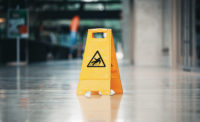Safety signage: No sharp edges, specific colors

 OSHA’s standard 1910.145(a)(1) covers the use of signs or symbols that warn of and define specific hazards that could harm workers or the public, or both, or to property damage. These specifications are intended to cover all safety signs except those designed for streets, highways, and railroads.
OSHA’s standard 1910.145(a)(1) covers the use of signs or symbols that warn of and define specific hazards that could harm workers or the public, or both, or to property damage. These specifications are intended to cover all safety signs except those designed for streets, highways, and railroads.
Not covered by these specifications: plant bulletin boards or to safety posters and bulletins used for employee education.
Kinds of signs:
- Danger signs indicate immediate danger and that special precautions are necessary.
- Caution signs shall be used only to warn against potential hazards or to caution against unsafe practices.
- Safety instruction signs. Safety instruction signs shall be used where there is a need for general instructions and suggestions relative to safety measures.
Design features
All signs shall be furnished with rounded or blunt corners and shall be free from sharp edges, burrs, splinters, or other sharp projections. The ends or heads of bolts or other fastening devices shall be located in such a way that they do not constitute a hazard.
Caution signs. The standard color of the background shall be yellow; and the panel, black with yellow letters. Any letters used against the yellow background shall be black.
Safety instruction signs. The standard color of the background shall be white; and the panel, green with white letters. Any letters used against the white background shall be black.
Slow-moving vehicle emblem. consists of a fluorescent yellow-orange triangle with a dark red reflective border. The yellow-orange fluorescent triangle is a highly visible color for daylight exposure. The reflective border defines the shape of the fluorescent color in daylight and creates a hollow red triangle in the path of motor vehicle headlights at night. The emblem is intended as a unique identification for, and it shall be used only on, vehicles which by design move slowly (25 m.p.h. or less) on the public roads.
Nature of wording
The wording of any sign should be easily read and concise. The sign should contain sufficient information to be easily understood. The wording should make a positive, rather than negative suggestion and should be accurate in fact.
Biological hazard signs. The biological hazard warning shall be used to signify the actual or potential presence of a biohazard and to identify equipment, containers, rooms, materials, experimental animals, or combinations thereof, which contain, or are contaminated with, viable hazardous agents. For the purpose of this subparagraph the term "biological hazard," or "biohazard," shall include only those infectious agents presenting a risk or potential risk to the well-being of man.
"Biological hazard" or "BIOHAZARD" means those infectious agents presenting a risk of death, injury or illness to employees.
What's a "major message"?
"Major message" means that portion of a tag's inscription that is more specific than the signal word and that indicates the specific hazardous condition or the instruction to be communicated to the employee. Examples include: "High Voltage," "Close Clearance," "Do Not Start," or "Do Not Use" or a corresponding pictograph used with a written text or alone.
Source: OSHA
Click here for more information.
Looking for a reprint of this article?
From high-res PDFs to custom plaques, order your copy today!






